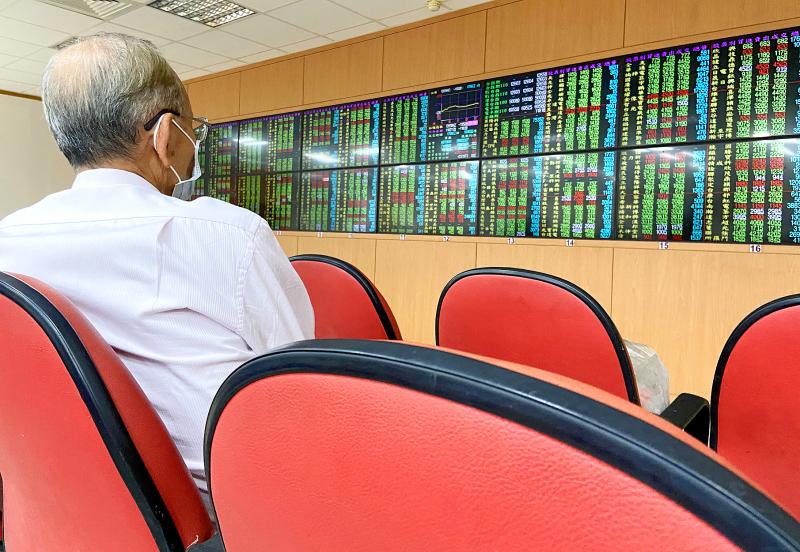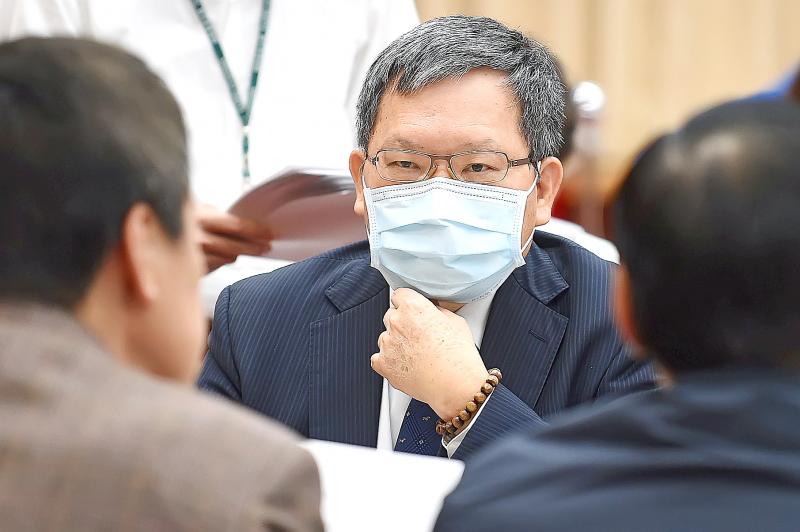The TAIEX yesterday shed 130.84 points, or 1.02 percent, to close at 12,662.91, taking cues from global bourses overnight as France and Germany announced four-week lockdowns to contain rising COVID-19 cases.
The benchmark fell 198.88 points by the middle of the session, after coronavirus woes plunged US stocks by 943.24 points — the worst since late July.
Panic selloffs prompted Minister of Finance Su Jain-rong (蘇建榮) to call for calm, saying that the government is closely monitoring the market and the state-run National Stabilization Fund would step in to shore up local shares if necessary.

Photo: CNA
“The fund can be activated any time the overseeing committee sees fit,” Su told lawmakers at a meeting of the legislature’s Finance Committee.
The minister attributed the stock retreat to surging virus infections in Europe and the US.
The National Stabilization Fund Committee on Oct. 12 pulled the NT$500 billion (US$17.29 billion) fund from the TAIEX, saying that it had achieved its goal of stabilizing the TAIEX, which had rebounded from March lows.

Photo: Chen Chih-chu, Taipei Times
Virus infections remain few in Taiwan — all since April 12 being imported from foreign countries — which explains why the nation’s economy has still grown this year, Su said, seeking to calm public unease.
Turnover on the main board yesterday amounted to NT$186.599 billion, Taiwan Stock Exchange data showed, which was relatively low compared with recent sessions, as investors turned cautious ahead of the US presidential election on Tuesday next week.
Foreign institutional players slashed net positions by NT$16.1 billion, while proprietary traders cut net holdings by NT$1.04 billion and mutual funds by NT$764 million, data showed.
Heavyweight technology was hit hard, as the share price of chipmaker Taiwan Semiconductor Manufacturing Co (台積電) fell 1.58 percent to NT$437, smartphone camera lens maker Largan Precision Co (大立光) declined 2.1 percent to NT$3,035 and printed circuit board maker Unimicron Technology Corp (欣興電子) fell by nearly the daily 10 percent limit to NT$67.9.
The TAIEX is susceptible to additional corrections in the near term, unless US and European bourses stabilize first, E-invest Securities Investment Consultant Co (倫元投顧) analyst Anderson Chien (錢冠州) said.
“The US presidential election poses another uncertainty and investors had better adopt a conservative strategy until the dust settles,” Chien said.
However, the share price of chip designer MediaTek Inc (聯發科) edged up 0.44 percent to NT$684, while contract chipmaker United Microelectronics Corp (UMC, 聯電) climbed 0.92 percent to NT$32.95, after it reached an agreement with the US Department of Justice to pay a US$60 million fine for trade-secret theft.
Taiwan Ratings Corp (中華信評) said that the settlement removes business uncertainty for UMC and would allow the company’s management to focus on its core foundry businesses.
The fine should only minimally affect the company’s capital structure, as UMC had more than NT$100 billion in cash and cash equivalents as of June 30, the ratings agency said.

TECH BOOST: New TSMC wafer fabs in Arizona are to dramatically improve US advanced chip production, a report by market research firm TrendForce said With Taiwan Semiconductor Manufacturing Co (TSMC, 台積電) pouring large funds into Arizona, the US is expected to see an improvement in its status to become the second-largest maker of advanced semiconductors in 2027, Taipei-based market researcher TrendForce Corp (集邦科技) said in a report last week. TrendForce estimates the US would account for a 21 percent share in the global advanced integrated circuit (IC) production market by 2027, sharply up from the current 9 percent, as TSMC is investing US$65 billion to build three wafer fabs in Arizona, the report said. TrendForce defined the advanced chipmaking processes as the 7-nanometer process or more

China’s Huawei Technologies Co (華為) plans to start mass-producing its most advanced artificial intelligence (AI) chip in the first quarter of next year, even as it struggles to make enough chips due to US restrictions, two people familiar with the matter said. The telecoms conglomerate has sent samples of the Ascend 910C — its newest chip, meant to rival those made by US chipmaker Nvidia Corp — to some technology firms and started taking orders, the sources told Reuters. The 910C is being made by top Chinese contract chipmaker Semiconductor Manufacturing International Corp (SMIC, 中芯) on its N+2 process, but a lack

Who would not want a social media audience that grows without new content? During the three years she paused production of her short do-it-yourself (DIY) farmer’s lifestyle videos, Chinese vlogger Li Ziqi (李子柒), 34, has seen her YouTube subscribers increase to 20.2 million from about 14 million. While YouTube is banned in China, her fan base there — although not the size of YouTube’s MrBeast, who has 330 million subscribers — is close to 100 million across the country’s social media platforms Douyin (抖音), Sina Weibo (新浪微博) and Xiaohongshu (小紅書). When Li finally released new videos last week — ending what has

NVIDIA PLATFORM: Hon Hai’s Mexican facility is to begin production early next year and a Taiwan site is to enter production next month, Nvidia wrote on its blog Hon Hai Precision Industry Co (鴻海精密), the world’s biggest electronics manufacturer, yesterday said it is expanding production capacity of artificial intelligence (AI) servers based on Nvidia Corp’s Blackwell chips in Taiwan, the US and Mexico to cope with rising demand. Hon Hai’s new AI-enabled factories are to use Nvidia’s Omnivores platform to create 3D digital twins to plan and simulate automated production lines at a factory in Hsinchu, the company said in a statement. Nvidia’s Omnivores platform is for developing industrial AI simulation applications and helps bring facilities online faster. Hon Hai’s Mexican facility is to begin production early next year and the